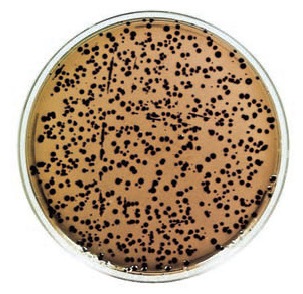E. COLI
Because of their comparative simplicity, bacteria are ideal models for studying many fundamental aspects of biochemistry and molecular biology. The most thoroughly studied species of bacteria is Escherichia coli (E. coli), which has long been the favored organism for investigation of the basic mechanisms of molecular genetics. Most of our present concepts of molecular biology including our understanding of DNA replication, the genetic code, gene expression, and protein synthesis derive from studies of this humble bacterium.
E.
coli has been especially useful to molecular biologists because of both
its relative simplicity and the ease with which it can be propagated and
studied in the laboratory. The genome of E. coli, for example, consists
of approximately 4.6 million base pairs and contains
about 4000 genes. The human genome is nearly
a thousand times larger (approximately 3 billion base pairs) and is thought to
contain about 20,000 protein-coding genes (see Table 1.2). The small size of
the E. coli genome provides obvious advantages for genetic analysis.
 |
Figure
1.15 Bacterial colonies Photograph
of colonies of E. coli growing on the surface of
an agar-containing medium.
Molecular genetic experiments are further facilitated by the rapid growth of E. coli under well-defined laboratory conditions. Under optimal culture conditions, E. coli divide every 20 minutes. Moreover, a clonal population of E. coli, in which all cells are derived by division of a single cell of origin, can be readily isolated as a colony grown on semisolid agar-containing medium (Figure 1.15). Because bacterial colonies containing as many as 108 cells can develop overnight, selecting genetic variants of an E. coli strain for example, mutants that are resistant to an antibiotic such as penicillin is easy and rapid. The ease with which such mutants can be selected and analyzed was critical to the success of experiments that defined the basic principles of molecular genetics, discussed in Chapter 4.
The
nutrient mixtures in which E. coli divide most rapidly include glucose,
salts, and various organic compounds, such as amino acids, vitamins, and
nucleic acid precursors. However, E. coli can also grow in much simpler
media consisting only of salts, a source of nitrogen (such as ammonia), and a
source of carbon and energy (such as glucose). In such a medium, the bacteria
grow a little more slowly (with a division time of about 40 minutes) because
they must synthesize all their own amino acids, nucleotides, and other organic
compounds. The ability of E. coli to carry out these biosynthetic
reactions in simple defined media has made them extremely useful in elucidating
the biochemical pathways involved. Thus, the rapid growth and simple
nutritional requirements of E. coli have greatly facilitated fundamental
experiments in both molecular biology and
biochemistry.




